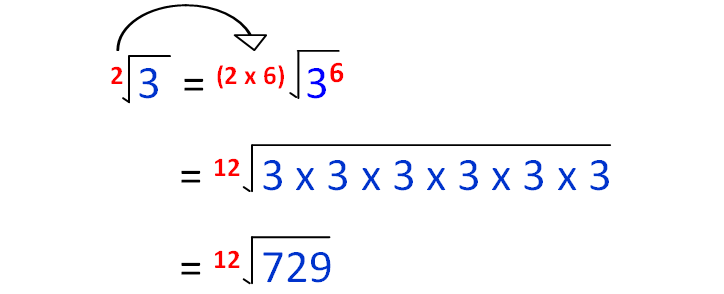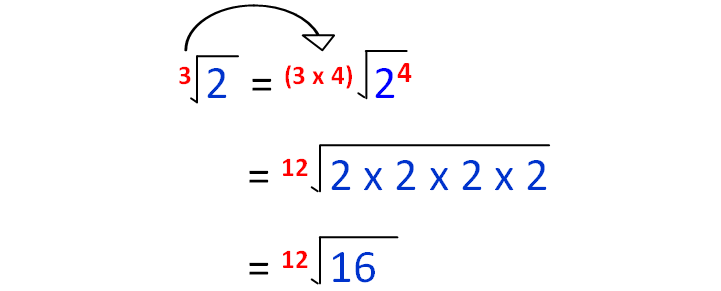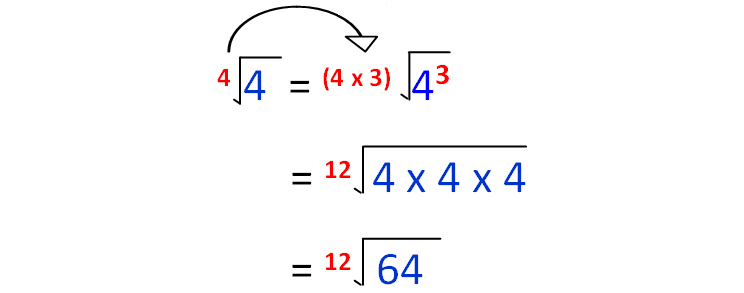COMPARING RADICALS
Subscribe to our ▶️ YouTube channel 🔴 for the latest videos, updates, and tips.
Radicals of same order :
3√3, 3√6, 3√10
Radicals of different orders :
√5, 3√4, 4√9
Radicand :
The value inside the radical sign.
Example :
In √x, x is the radicand.
Comparing Radicals of Same Order
To compare two or more radicals of same order, we have to compare the radicands.
For example, let us consider the following two radicals of same order.
3√9 and 3√7
In the above two radicals, the radicands are 9 and 7.
And also,
9 > 7
Then
3√9 > 3√7
Comparing Radicals of Different Orders
To compare two or more radicals of different orders, first we have to convert them into radicals of different orders. Then, we have compare the radicands.
Using the least common multiple of the different orders given, we can convert the radicals of different orders into radicals of same order.
For example, let us consider the following radicals of different orders.
√3, 3√2 and 4√4
The orders of the above radicals are 2, 3 and 4.
Thee least common multiple of (2, 3 and 4) is 12.
So, we have to make the order of each radical as 12.
Then,




From the above calculations,
√3 = 12√729
3√2 = 12√16
4√4 = 12√64
Now, all radicals are expressed in the same order.
Compare the radicands :
729 > 64 > 16
Then,
12√729 > 12√64 > 12√16
Therefore,
√3 > 4√4 > 3√2
Comparing Radicals with Same Radicand
If two radicals of different orders have the same radicand, then the radical with the smaller order will be greater in value.
For example,
3√5 > 5√5
Practice Questions
Question 1 :
Which is greater ?
√4 or √6
Answer :
The above two radicals have the same order (i.e., 2).
To compare the above radicals, we have to compare the radicands 4 and 6.
Clearly 6 is greater than 4.
So, √6 is greater than √4.
That is,
√6 > √4
Question 2 :
Which is greater ?
√2 or 3√3
Answer :
The above two radicals have different orders. The are 2 and 3.
Using the least common multiple of the orders 2 and 3, we can convert them into radicals of same order.
Least common multiple of (2 and 3) is 6.
Then,
√2 = 2x3√(23) = 6√8
3√3 = 3x2√(32) = 6√9
Now, the given two radicals are expressed in the same order.
Compare the radicands :
9 > 8
Then,
6√9 > 6√8
Therefore,
3√3 > √2
Question 3 :
Which is greater ?
4√3 or 6√4
Answer :
The above two radicals have different orders. The are 4 and 6.
Using the least common multiple of the orders 4 and 6, we can convert them into radicals of same order.
Least common multiple of (4 and 6) is 12.
Then,
4√3 = 4x3√(33) = 12√27
6√4 = 6x2√(42) = 12√16
Now, the given two radicals are expressed in the same order.
Compare the radicands :
27 > 16
Then,
12√27 > 12√16
Therefore,
4√3 > 6√4
Question 4 :
Which is greater ?
4√4 or 5√5
Answer :
The above two radicals have different orders. The are 4 and 5.
Using the least common multiple of the orders 4 and 5, we can convert them into surds of same order.
Least common multiple of (4 and 5) is 20.
Then,
4√4 = 4x5√(45) = 20√1024
5√5 = 5x4√(54) = 20√625
Now, the given two radicals are expressed in the same order.
Compare the radicands :
1024 > 625
Then,
20√1024 > 20√625
Therefore,
4√4 > 5√5
Question 5 :
Which is greater ?
7√25 or 5√25
Answer :
The above two radicals have different orders with the same radicand.
Then, the radical with the smaller order will be greater in value.
Therefore, 5√25 is greater than 7√25.
That is,
5√25 > 7√25
Question 6 :
Arrange the following radicals in ascending order :
3√4, 6√5 and 4√6
Answer :
The orders of the above radicals are 3, 6 and 4.
The least common multiple of (3, 6 and 4) is 12.
So, we have to make the order of each radical as 12.
Then,
3√4 = 3x4√(44) = 12√256
6√5 = 6x2√(52) = 12√25
4√6 = 4x3√(63) = 12√216
Now, the given two radicals are expressed in the same order.
Arrange the radicands in ascending order :
25, 216, 256
Then,
12√25, 12√216, 12√256
Therefore, the ascending order of the given radicals is
6√5, 4√6, 3√4
Subscribe to our ▶️ YouTube channel 🔴 for the latest videos, updates, and tips.
Kindly mail your feedback to v4formath@gmail.com
We always appreciate your feedback.
About Us | Contact Us | Privacy Policy
©All rights reserved. onlinemath4all.com

Recent Articles
-
10 Hard SAT Math Questions (Part - 44)
Jan 12, 26 06:35 AM
10 Hard SAT Math Questions (Part - 44) -
US Common Core K-12 Curricum Algebra Solving Simple Equations
Jan 07, 26 01:53 PM
US Common Core K-12 Curricum Algebra Solving Simple Equations -
10 Hard SAT Math Questions (Part - 4)
Jan 05, 26 06:56 PM
10 Hard SAT Math Questions (Part - 4)
